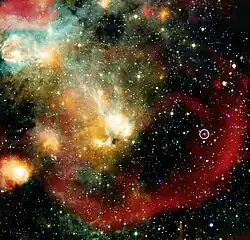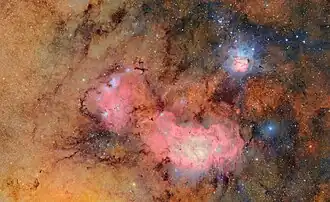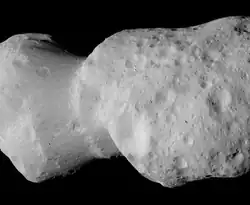ASKAP J1832−0911
 A wide field image of ASKAP J1832 in X-ray, radio, and infrared light (circled). Credit: X-ray: NASA/CXC/ICRAR, Curtin Univ./Z. Wang et al.; Infrared: NASA/JPL/CalTech/IPAC; Radio: SARAO/MeerKAT; Image processing: NASA/CXC/SAO/N. Wolk | |
| Observation data Epoch J2000 Equinox J2000 | |
|---|---|
| Constellation | Scutum[1] |
| Right ascension | 18h 32m 48.4589s |
| Declination | −9° 11′ 15.297″ |
| Characteristics | |
| Evolutionary stage | White dwarf or magnetar (suspected) |
| Astrometry | |
| Details | |
| Database references | |
| SIMBAD | J1832-0911 data |
ASKAP J1832-0911 is a stellar object referred to as an extremely bright "long period radio transient" (LPT). Its unusual properties are unlike those of any other known object. It is has been hypothesized to be either an old magnetar or an ultra magnetized white dwarf,[1][2] although discoverer Ziteng Wang says that "those theories do not fully explain what we are observing."[3]
Discovery
ASKAP J1832 was identified through observations taken at the Australian Square Kilometre Array Pathfinder, and was serendipitously discovered in the X-ray band when a coincident observation conducted through the Chandra X-ray Observatory targeting the supernova remnant SNR G22.7–0.2 was able to detect it.[4][2]
Properties
A body referred to as a long-period transient (LPT), ASKAP J1832 is a body which emits radio pulses and x-ray radiation 2 minutes in duration every 44 minutes and is located within the Milky Way about 15,000 light-years away from Earth.[4] There exists uncertainty of the object's stellar identity, with some believing it may be a magnetar or a white dwarf.[4]
References
- ^ a b "Chandra :: Photo Album :: ASKAP J1832-0911 :: May 28, 2025". chandra.si.edu. 28 May 2025. Retrieved 29 May 2025.
- ^ a b Wang, Ziteng; Rea, Nanda; Bao, Tong; Kaplan, David L.; Lenc, Emil; Wadiasingh, Zorawar; Hare, Jeremy; Zic, Andrew; Anumarlapudi, Akash; Bera, Apurba; Beniamini, Paz; Cooper, A. J.; Clarke, Tracy E.; Deller, Adam T.; Dawson, J. R.; Glowacki, Marcin; Hurley-Walker, Natasha; McSweeney, S. J.; Polisensky, Emil J.; Peters, Wendy M.; Younes, George; Bannister, Keith W.; Caleb, Manisha; Dage, Kristen C.; James, Clancy W.; Kasliwal, Mansi M.; Karambelkar, Viraj; Lower, Marcus E.; Mori, Kaya; Ocker, Stella Koch; Pérez Torres, Miguel; Qiu, Hao; Rose, Kovi; Shannon, Ryan M.; Taub, Rhianna; Wang, Fayin; Wang, Yuanming; Zhao, Zhenyin; Bhat, N. D. Ramesh; Dobie, Dougal; Driessen, Laura N.; Murphy, Tara; Jaini, Akhil; Deng, Xinping; Jahns-Schindler, Joscha N.; Lee, Y. W. Joshua; Pritchard, Joshua; Tuthill, John; Thyagarajan, Nithyanandan (28 May 2025). "Detection of X-ray emission from a bright long-period radio transient". Nature. 642 (8068): 583–586. arXiv:2411.16606. Bibcode:2025Natur.642..583W. doi:10.1038/s41586-025-09077-w. ISSN 1476-4687. PMID 40437090.
- ^ D'Monte, Charlene (28 May 2025). "Cosmic mystery deepens as astronomers find object flashing in both radio waves and X-rays" (Press release). International Centre for Radio Astronomy Research. Retrieved 16 June 2025.
- ^ a b c Lea, Robert (28 May 2025). "Astronomers discover mystery cosmic body bursting with X-rays: 'This object is unlike anything we have seen before'". Space. Retrieved 29 May 2025.


